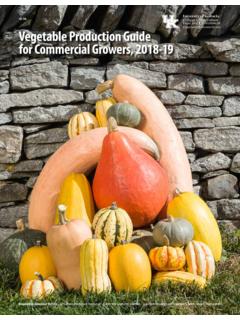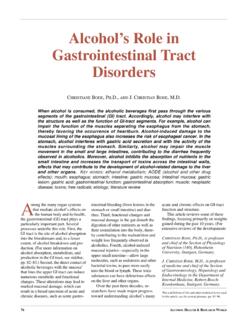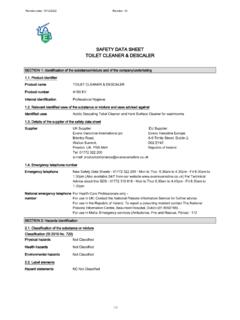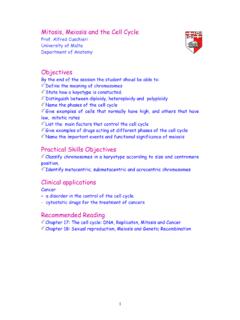Transcription of ASC-203: Avian Digestive System - University of Kentucky
1 COOPERATIVE EXTENSION SERVICE. University OF Kentucky COLLEGE OF AGRICULTURE, FOOD AND ENVIRONMENT, LEXINGTON, KY, 40546. ASC-203. Avian Digestive System Jacquie Jacob and Tony Pescatore, Animal Sciences An understanding of the Avian Beak / Mouth: Chickens, as with Crop: The crop is an out-pocket- Digestive System is essential to most birds, obtain feed with the ing of the esophagus and is located developing an effective and eco- use of their beak. Food picked up just outside the body cavity in the nomical feeding program for your by the beak enters the mouth. As neck region (see Figure 3). Any poultry flock. Knowledge of Avian previously mentioned, chickens swallowed feed and water is stored anatomy, and what the parts nor- do not have teeth so they are not in the crop until it is time to pass it mally look like, will also help you able to chew their food.
2 The mouth on to the rest of the Digestive tract . to recognize when something is does contain glands which secrete When the crop is empty, or nearly wrong and take the necessary ac- saliva which wets the feed to make empty, it sends hunger signals to tions to correct the problem. it easier to swallow. The saliva also the brain so that the chicken will The Digestive tract of any contains some enzymes which start eat more. animal, including chickens, is the digestion of the food eaten. Although salivary glands of the important in converting the food The chicken's tongue is then used mouth secrete the Digestive en- the animal eats into the nutrients to push the feed to the back of the zyme amylase very little digestion their body needs for maintenance, mouth so that it can be swallowed.
3 Actually takes place in the crop it growth, and production (such as Esophagus: The esophagus is is primarily a temporary storage eggs or meat). Once food is eaten, it a flexible tube that connects the pouch. The crop evolved for birds must be broken down into its basic mouth with the rest of the diges- that need to move to the open to components. This is done through tive tract . It carries food from the find feed but are typically hunted both mechanical and chemical mouth to the crop and from the by other animals. These birds are means. crop to the proventriculus. able to consume relatively large Mechanical action typically in- volves chewing, but since birds do not have teeth other me- chanical methods are used. Chemical action includes the release of Digestive enzymes and fluids from the stomach, pancreas and liver.
4 Once the nutrients have been re- leased from food during digestion, they can be absorbed and distrib- uted throughout the animal's body. The Digestive tract is also referred to as the gastro - intestinal or GI. tract . Whichever term is used, in birds it begins at the mouth and ends at the cloaca and has several important organs in between (see the Figure 2). Figure 1. Model showing the internal organs of the female chicken Source: PoultryHub Agriculture and Natural Resources Family and Consumer Sciences 4-H Youth Development Community and Economic Development EXTENSION. the feed here and digestion begins. At this point, however, the food has not yet been ground up. The term proventriculus' is used since it comes before the ventriculus'.
5 Or gizzard, with pro' being a Latin terming meaning before. Gizzard / Ventriculus: The giz- zard, or ventriculus, is a part of the Digestive tract unique to birds. It is often referred to as the mechani- cal stomach'. It is made up of two sets of strong muscles which act as the bird's teeth. Consumed feed and the Digestive juices from the salivary glands and the proven- triculus pass into the gizzard for grinding, mixing, and mashing. When allowed to free-range, chickens will typically eat small stones. These stones remain in the Figure 2. Parts of the Digestive tract of a chicken gizzard until they become ground into pieces small enough to pass amounts of food quickly and then come impacted in a chicken that is through to the rest of the Digestive move to a more secure location to free-ranged on a pasture of tough, tract .
6 The stones/pebbles are weak- digest the food they consumed. fibrous vegetation. Crop impaction ened by the acidic environment Occasionally the crop becomes can also result when the chickens created in the proventriculus and impacted or 'backed up' (crop eat a long piece of string. With a then are ground into tiny pieces by impaction, also referred to as crop crop impaction, even if a chicken the strong muscles of the gizzard. binding or pendulous crop). This continues to eat, the feed cannot Chickens fed whole grains need may occur when chickens go a long get past the impacted crop. There is to have access to small pebbles or time without feed. This will cause very little that can be done to treat given a product called grit. Grit the chickens to eat too much too a chicken with pendulous crop.
7 Is a commercial product made up fast when the feed becomes avail- Proventriculus: The esophagus of small stones. It should not be able again. A crop may also be- continues past the crop to connect confused with limestone or oyster the crop to the shell which is given to laying hens proventriculus. as a source of calcium for their egg The proven- shells. Chickens kept on pasture triculus (also will also require supplementation known as the with grit, though many of them true stomach') may consume enough pebbles is the glandular when they forage. Chickens fed stomach where only commercially prepared feed digestion begins. do not need grit. As with human Gizzards have a thick lining stomachs, hy- which protects the muscles from drochloric acid the acidic condition of the digesta and Digestive en- coming from the proventriculus.
8 Zymes ( , pep- When chickens are slaughtered, sin) are added to the gizzards are often saved, the lining removed, and the gizzard Figure 3. Location of the crop in a chicken. The crop is consumed by the family or sold as located just outside the body cavity in the neck region. a food item. When a chicken eats a small, pasty droppings that often smell sharp object such as a tack or worse than regular droppings. staple, the object is likely to get Cecal droppings typically have a stuck in the gizzard. Because of the mustard to dark brown in color. strong grinding motion of the giz- The number of times cecal drop- zard's muscles, these sharp objects pings are released, as well as their may eventually put a hole in the color and texture, tell you that the gizzard wall.
9 Chickens with dam- chicken's Digestive tract is func- aged gizzards will grow thin and tionally normally. eventually die a very good reason Large intestine (also known as to keep your poultry houses free of Figure 4. The position of the Meckel's the colon): Despite the name, the nails, glass shards, bits of wire and diverticulum between the jejunum large intestine is actually shorter the like. and ileum portions of the small than the small intestine. The large Small intestine: The small intestine. intestine is where the last of the intestine is made up of the duo- water re-absorption occurs. denum (also referred to as the purchased online and shipped via Cloaca: In the cloaca there is duodenal loop) and the lower small the postal service.
10 A mixing of the Digestive wastes intestine. The duodenum receives In recently hatched chicks, the together with wastes from the uri- Digestive enzymes and bicarbonate yolk sac enters the body and the nary System (urates). Fecal material (to counter the hydrochloric acid navel closes. Sometimes the na- is usually voided as Digestive waste from the proventriculus) from the vel may be inflamed and fail to with white uric acid crystals on pancreas and bile from the liver close, producing a wet spot on the the outer surface. The reproduc- via the gall bladder. The Digestive abdomen. A scab may be present. tive tract also exits through this enzymes produced by the pancreas Omphalitis is a condition charac- area but when a hen lays an egg the are primarily involved in protein terized by infected yolk sacs, often vagina folds over to allow the egg digestion.














